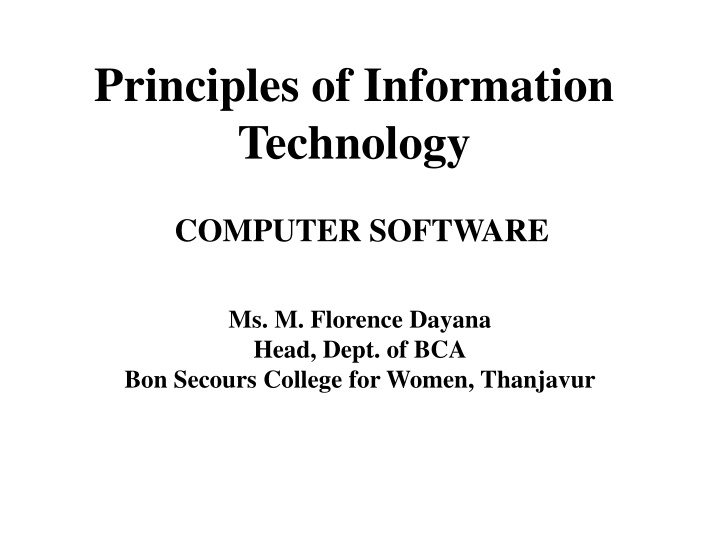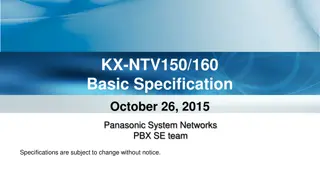
Computer Software: Types and Classes Explained
Dive into the world of computer software with this comprehensive guide. Discover the different types of software, such as system and application software, and explore various classes like operating systems, word processors, spreadsheets, and image processors. Learn how software plays a crucial role in the functioning of a computer system.
Uploaded on | 0 Views
Download Presentation

Please find below an Image/Link to download the presentation.
The content on the website is provided AS IS for your information and personal use only. It may not be sold, licensed, or shared on other websites without obtaining consent from the author. If you encounter any issues during the download, it is possible that the publisher has removed the file from their server.
You are allowed to download the files provided on this website for personal or commercial use, subject to the condition that they are used lawfully. All files are the property of their respective owners.
The content on the website is provided AS IS for your information and personal use only. It may not be sold, licensed, or shared on other websites without obtaining consent from the author.
E N D
Presentation Transcript
Principles of Information Technology COMPUTER SOFTWARE Ms. M. Florence Dayana Head, Dept. of BCA Bon Secours College for Women, Thanjavur
INTRODUCTION TO COMPUTER SOFTWARE A computer needs both hardware and software for its proper functioning. Software classified into two types 1. System software 2. Application software System software consists of low-level programs that interact with the computer at a very basic level. Application software also called end-user programs. It includes database programs, word processors, and spreadsheets.
SOFTWARE TYPES Systems Software Operating Systems File Management Tools Assemblers Compliers Debuggers Utilities Applications Software Image Processors Word Processors Databases Spreadsheets Games Communication Software
CLASSES OF SOFTWARE OPERATING SYSTEMS Operating systems are the most important programs that run on a computer. Operating systems include Microsoft Windows, DOS, Xenix, Mac OS, OS/2, UNIX, MVS, etc. UTILITIES Utility is a program that performs a very specific tasks, usually related to managing system resources. For example: word processors, spreadsheet programs, and database applications. COMPILERS AND INTERPRETERS Compiler is a program that translate source code into object code. The advantage of interpreters is that they execute a program immediately.
CLASSES OF SOFTWARE WORD PROCESSORS A word processor is a program that enables you to perform word processing functions. Some of the commonly used word processors are Microsoft Word, WordStar, WordPerfect, Amipo, etc. SPREADSHEETS A Spreadsheet is a tables of values arranged in rows and columns. PRESENTATION GRAPHICS Presentation graphics enable users to create highly stylized images for slide shows and reports. DATABASE MANAGEMENT SYSTEMS (DBMS) A DBMS is a collection of programs that enables you to store, modify, and extract information from a database.
CLASSES OF SOFTWARE IMAGE PROCESSORS Image processors or graphics programs enable you to create, edit, manipulate, add special effects, view, print and save images. PAINT PROGRAMS A paint program is a graphics program that enables you to draw pictures on the display screen, which are represented as bit maps (bit mapped graphics). DRAW PROGRAMS A draw programs is another graphics program that enables you to draw pictures, then store the images in files, merge them into document, and print them. IMAGE EDITORS Image Editors is a graphics program that provides a variety of special features for altering bit-mapped images.
OPERATING SYSTEMS INTRODUCTION An operating systems manages and coordinates the functions performed by computer hardware, including the CPU, input/output devices, secondary storage devices, and communication and network equipment. The primary purpose of an operating system is to maximize the productivity of a computer system by operating it in the most efficient manner and minimizing the amount of human intervention required. Many operating systems are designed as a collection of program modules, which can be organized in combination with various capabilities around a central module, or kernel. Example of popular microcomputer operating systems are Windows, DOS, OS/2, for PCs and Mac OS for Apple computers, etc. Some examples of operating systems for minicomputers are UNIX, OS/400, etc. An example of an operating system for a mainframe in MVS.
FUNCTIONS OF OPERATING SYSTEM
UNIX OPERATING SYSTEM KERNEL 1. Interprets user s commands a. Programming languages b. Text Processors 2. Interfaces with other subsystems a. File and directory systems 3. Provides a flexible command language a. Communications & Networking b. Utilities 4. Shell a. Programs
OPERATING SYSTEM OS/2 Kernel 1. Presentation Manager 2. Communication Manager 3. Database Manager 4. Application Programming Interface 5. Device Drivers 6. Utilities THE MVS OPERATING SYSTEM 1. Storage Management 2. Data Management 3. Recovery Management 4. Supervisor services 5. Job Entry Subsystems
FUNCTIONS OF AN OPERATING SYSTEM Job Management - Job management software manages the jobs waiting to be proceed. Batch Processing - System software is available to support the different methods of processing a job. On-line Processing - In on-line processing, data are processed instantaneously. Data Management - In the process of managing the resources of the computer system, operating system software also manages the storage and retrieval of data. VirtualStorage - Operating systems also manages the allocation of main memory jobs. Some Operating system have a feature called virtual storage. Input/Output Management - Operating systems also manage the input to and output from a computer system.
CLASSIFICATION OF OPERATING SYSTEM Multi-user Multi-user operating systems allow two or more users to run programs at the same time. Multiprocessing Multiprocessing refers to a computers system s ability to support more than one process (program) at the same time. Multitasking Multitasking allows more than one program to run concurrently. Two types are preemptive and cooperative Multithreading Multithreading is the ability of an operating system to execute different parts of program, called threads, simultaneously. Real-time Real-time operating systems are systems that respond to input immediately.
PROGRAMMING LANGUAGE INTRODUCTION Programming languages are said to be lower or higher, depending on whether they are closer to the language the computer itself uses or to the language that people use. The five levels of language. 1. Machine Languages/First-generation languages 2. Assembly Languages/Second-generation languages 3. Procedural Language/Third-generation languages 4. Problem-oriented Languages/Fourth-generation Languages 5. Natural Languages/Fifth-generation Languages The high-level languages such as pascal, BASIC, and COBOL, and are the ones used to code applications programs, it is described as a user-friendly language.
LANGUAGES MACHINE LANGUAGES The binary system is based on two digits - 0 and 1. The decimal system that we all use is based on ten digits - to 9. Letters of the alphabet are also represented as numbers. Commas, semicolons, and other special characters are also represented as bunches of 0s and 1s. ASSEMBLY LANGUAGES Assembly languages, also known as symbolic languages use abbreviations or mnemonic code codes more easily memorized to replace the 0s and 1s of machine languages. Assembly languages do not replace machine languages. Assembly languages code is very similar in form to machine language code.
HIGH LEVEL LANGUAGES High level languages assisted programmers by reducing further the number of computer operation details they had to specify, so that they could concentrate more on the logic needed to solve the problem. High level languages into three generations: 1. Procedural-oriented or third generation 2. Problem-oriented or fourth generation 3. Natural or fifth generation
DIFFERENCES BETWEEN 3GLs and 4GLs Third-generation languages Use by professional programmers Fourth-generation languages Used by a non-programming end user as well as a professional programmers Default alternatives are build in; Require far fewer instructions All alternatives must be specified Require large number of procedural instructions Code may be difficult to read, understand and maintain Code is easy to understand and maintain because of English-like commands Language developed primarily for on- line use. Easy to learn Easy to debug Language developed for batch operation Can be difficult to learn Difficult to debug
NATURAL LANGUAGES Natural languages are still in the developmental stages, but they promise to have profound effect, particularly in the areas of artificial intelligence and expert systems. TWO CHARACTERISTICS 1.More humanlike 2. Smarter Two popular natural languages are LISP and PROLOG
COMPILERS In a complied language, a translation program is run to covert the programmer s entire high-level program, which is called the source code, into a machine language code. This translation process is called compilation. Some of the most widely used complied languages are COBOL, C, C++, FORTRAN, etc. INTERPRETERS In an interpreted language, a translation program converts each program statement into machine code just before the program statement is to be executed. THECOMPILATIONPROCESS The objective of the compiler is to transform a program written in a high- level programming language from source code into object code. Programmers write programs in a form called source code.
GENERAL SOFTWARE FEATURES AND TRENDS INTRODUCTION A series of instructions that perform a particular task is called a program. System software is made up of control programs, communications software and database manager. Application software is any program that process data for the user (inventory, payroll, spreadsheet, word processor, etc. Computer software is becoming more and more complex and the amount of software that is being developed each year is increasing at an exponential rate. The software is being used to control a range of activities from mission critical applications like controlling the operations of satellites and Intercontinental Ballistic and Missiles (ICBMs) Software systems are subject to constant changes during design, during development and even after development.
FEATURES AND TRENDS EASE OF USE The software systems and applications are becoming more and more easy to use. GRAPHICALUSERINTERFACE (GUI) GUI or graphical user interface has now become the de facto standard for most of the software applications. MOREFEATURES The number of new software companies and the number of new software products are increasing day by day. MULTI-PLATFORMCAPABILITY There are software applications that support hardware platforms ranging from mainframes to PCs and different software platforms like MVS, Solaris, AIX, UNIX, Windows and so on. Important feature of today s software applications is that they support multiple language and multiple currencies.
FEATURES AND TRENDS NETWORKCAPABILITIES Network computers are computers with minimal memory, disk, storage and processor power designed to connect to a network, especially the Internet. COMPATIBILITYWITHOTHERSOFTWARE User of one software can migrate or convert all his/her existing files to the other system without any trouble. OBJECTLINKINGANDEMBEDDING OLE is a compound document standard developed by Microsoft Corporation. It enables you to create objects with one applications and then link or embed them in a second application.
FEATURES AND TRENDS GROUPWORK CAPABILITIES Groupware is an umbrella term describing the electronic technologies they support person-to-person collaboration. Groupware includes E-mail, Electronic Meeting system (EMS), Desktop Video Conferencing (DVC) as well as systems for workflow and Business Process Re-engineering (BPR). MAIL ENABLING The mail enabling of an application is the process through which e-mail is gradually replacing many of the single purpose applications now used on personal computers. Mail enabled applications are designed to capitalize on e-mail.
FEATURES AND TRENDS WEB ENABLING Web enabling helps the user in many different ways. Its use starts while the user is installing the applications. Today s web-enabled software programs are capable of accessing the Internet for getting the information they do not have locally on the user s machine. For example, Word 2000 can now connect to the Microsoft s web site and get clipart images and pictures that are not available on the local machine or if the user is not satisfied with the available images.

